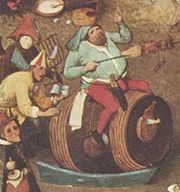
The Fight Between Carnival and Lent
Encyclopedia
The Fight Between Carnival and Lent is an oil
-on-panel work painted by Pieter Bruegel in 1559. This painting depicts a common festival of the period, as celebrated in the Southern Netherlands. It presents the contrast between two sides of contemporary life, as can be seen by the appearance of the inn on the left side - for enjoyment, and the church on the right side - for religious observance. The busy scene depicts well-behaved children near the church and a beer drinking scene near the inn. Other scenes show a well in the centre (the coming together of different parts of the community), a fish stall and two competing floats.
A battle enacted between the figures Carnival
and Lent
was an important event in community life in early modern Europe, representing the transition between two different seasonal cuisines: livestock that was not to be wintered was slaughtered, and meat was in good supply. As the period of Lent commenced, with its enforced abstinence and the concomitant spiritual purification in preparation for Easter
, the butcher shops closed and the butchers travelled into the countryside to purchase cattle for the spring.
 The figure of Carnival was a fat man who led a procession through the town and presided over a large feast. In some traditions an effigy
The figure of Carnival was a fat man who led a procession through the town and presided over a large feast. In some traditions an effigy
of the Carnival figure was burned at the end of the celebrations. In Bruegel's painting the figure is a large man riding a wine barrel, wearing a huge pie as a head-dress; he is wielding a long spit, complete with a pig's head, as a weapon for the fight.
The painting currently resides in the Kunsthistorisches Museum
in Vienna
.
Oil painting
Oil painting is the process of painting with pigments that are bound with a medium of drying oil—especially in early modern Europe, linseed oil. Often an oil such as linseed was boiled with a resin such as pine resin or even frankincense; these were called 'varnishes' and were prized for their body...
-on-panel work painted by Pieter Bruegel in 1559. This painting depicts a common festival of the period, as celebrated in the Southern Netherlands. It presents the contrast between two sides of contemporary life, as can be seen by the appearance of the inn on the left side - for enjoyment, and the church on the right side - for religious observance. The busy scene depicts well-behaved children near the church and a beer drinking scene near the inn. Other scenes show a well in the centre (the coming together of different parts of the community), a fish stall and two competing floats.
A battle enacted between the figures Carnival
Carnival
Carnaval is a festive season which occurs immediately before Lent; the main events are usually during February. Carnaval typically involves a public celebration or parade combining some elements of a circus, mask and public street party...
and Lent
Lent
In the Christian tradition, Lent is the period of the liturgical year from Ash Wednesday to Easter. The traditional purpose of Lent is the preparation of the believer – through prayer, repentance, almsgiving and self-denial – for the annual commemoration during Holy Week of the Death and...
was an important event in community life in early modern Europe, representing the transition between two different seasonal cuisines: livestock that was not to be wintered was slaughtered, and meat was in good supply. As the period of Lent commenced, with its enforced abstinence and the concomitant spiritual purification in preparation for Easter
Easter
Easter is the central feast in the Christian liturgical year. According to the Canonical gospels, Jesus rose from the dead on the third day after his crucifixion. His resurrection is celebrated on Easter Day or Easter Sunday...
, the butcher shops closed and the butchers travelled into the countryside to purchase cattle for the spring.

Effigy
An effigy is a representation of a person, especially in the form of sculpture or some other three-dimensional form.The term is usually associated with full-length figures of a deceased person depicted in stone or wood on church monuments. These most often lie supine with hands together in prayer,...
of the Carnival figure was burned at the end of the celebrations. In Bruegel's painting the figure is a large man riding a wine barrel, wearing a huge pie as a head-dress; he is wielding a long spit, complete with a pig's head, as a weapon for the fight.
The painting currently resides in the Kunsthistorisches Museum
Kunsthistorisches Museum
The Kunsthistorisches Museum is an art museum in Vienna, Austria. Housed in its festive palatial building on Ringstraße, it is crowned with an octagonal dome...
in Vienna
Vienna
Vienna is the capital and largest city of the Republic of Austria and one of the nine states of Austria. Vienna is Austria's primary city, with a population of about 1.723 million , and is by far the largest city in Austria, as well as its cultural, economic, and political centre...
.

